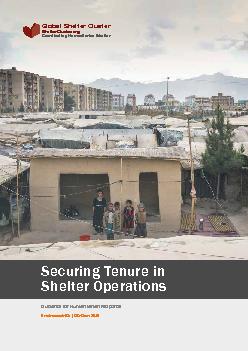Resources
SECURING TENURE IN SHELTER OPERATIONS
In a number of regions and contexts where humanitarian shelter programmes are implemented, the use of and access to land and housing by individuals and communities is of a different character and subject to a different type of governance than in the Global North context of formal ownership evidenced by written documents and official records.
Despite this operational reality, until recently, both donors and shelter agencies have largely adhered to traditional notions of shelter based on individual property ownership, given the view that this was the only sufficiently secure form of tenure. As a result, people lacking individual ownership – often among the most vulnerable – were excluded from shelter assistance.
This guidance is part of The Global Shelter Cluster’s and the HLP AoR’s efforts to develop an operational definition of security of tenure applicable in humanitarian settings, which will enable the sector to effectively address the shelter needs of its beneficiaries. It incorporates learning from field operations as they apply basic concepts of security of tenure together with knowledge of the local context to devise shelter solutions based on the legal realities and the diversity of tenure systems and tenure forms in place.
Shelter actors strive to promote the design of flexible solutions with tenure that is secure enough; by providing the greatest degree of protection for beneficiaries that is feasible in the context. On the one hand is the ideal of formal tenure with a high degree of security evidenced by official documents. On the other, the immediate need of beneficiaries for some security in a situation where formal documented tenure is difficult to obtain.
This document presents operational efforts in a range of contexts to find the right balance, using tenure options for beneficiaries short of private ownership, with emphasis on how tenure can be secured and documented in the absence of rules or documentation issued by formal authorities. Going forward, one goal is to continue to explore options for the use of additional forms of tenure.

